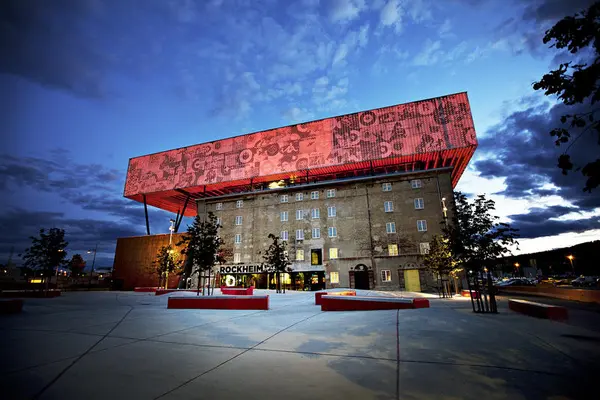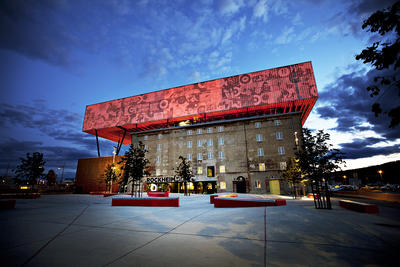-
Rockheim Geir Mogen/Rockheim
During the last three decades there has been an increasing interest in the cultural value of popular music and its material past. This has led to the establishment of a wide range of archives, museums and Hall of Fame-institutions, dedicated to collecting, preserving, curating and celebrating popular music as cultural heritage.
But how can music, as an ephemeral and sometimes immaterial cultural expression, transform into cultural heritage? What does this cultural heritage consist of? And how is it preserved and communicated in archives and museums? What stories are told, by whom, how are they told, and who are listening?
These are some of the questions that we would like to reflect on and discuss with people working in museums, archives, libraries, journalists, musicians, students, scholars, people working in the music industry and people interested in culture and cultural history.
Registration NOK 1500,- per person
- Please note that the first registration form field is your Email address
- When you have signed up, you’ll recived email information on how to transfer the fee
- Please note that this fee includes the registration fee, lunch, refreshments and coffee both days, and a buffet style dinner on day 1
The Conference is organized by the Nordic Network of Popular Music Museums:
Ragnarock Museum for Pop, Rock and Youth Culture (Denmark)
Rockheim the National Museum of Popular music (Norway)
Rokksafn – the Icelandic Museum of Rock’n’roll
DAY #1
10.00: Registration and coffee
10.30: Welcome and introduction by Sissel Guttormsen, Director at Rockheim
10.40: Musical interlude - Kari Harneshaug
Session 1: Popular music as cultural heritage
11:00: Whose heritage is it anyway?
Andy Bennett, Professor, Centre for Social and Cultural Research, Griffith University, Australia
In Tony Palmer’s seventeen part documentary All You Need is Love: The Story of Popular Music, released in 1977, the popular music icons of the 1950s and 1960s are rarefied while the likes of Kiss are dismissed as what is referred to in the documentary as ‘sour rock’. By comparison, if we fast-forward to 2019 Kiss’s heritage rock status is widely acknowledged and barely disputed in rock circles. As such, specific artists, and in some cases whole genres, embody a significant degree of generational memory and nostalgia. But what does this say about popular music ‘heritage’ overall, and is heritage even the right term through which to understand a process that appears to be in a continual state of flux - and where so much depends on who is applying the heritage label and their motivations for doing so? Of course, there is much to be said about the potential of things such as digital media and DIY music archives to effectively democratize the popular music heritage making process. With so many contingencies built into the rapidly expanding sphere of popular music heritage, how are we to define what is and what isn’t heritage – or is popular music heritage simply in the eye of the beholder? The purpose of this keynote lecture is to begin teasing out answers to some of these complex questions.
11:45: Questions
12:00: Popular Music in Museums: Heritage, Memory and Representation
Marion Leonard, Senior Lecturer at Liverpool Institute of Popular Music, UK
Popular music has become a hot topic within the heritage sector, signalled
by high profile exhibitions at leading institutions and the establishment
of dedicated national centres. Museums play a central role in preserving,
caring for and making accessible materials which document and evidence
diverse music histories and practices. The status of museums means that
they have also been important in establishing an understanding of popular
music and associated materials as heritage. This presentation will
discuss the practices and activities of museums and consider the issues
that they raise about how we understand, value and remember the history
of popular music. Moreover it will examine not just what museums do but
who they are for – considering their work in both representing music
histories and allowing visitors to place themselves in relation to that past.
12:30: Questions and debate
13.00: Lunch
Session 2: Papers
14.00: Ola Mitsui, Event Manager at Charlotty Valley Amphitheater, Poland: Presenting the Museum of Rock Legend Festival
14.20: Questions
14.25: Marilisa Merolla, Associate Professor of Contemporary History, Sapienza University of Rome, Italy: The Pop Power Revolution Project. Teaching sound as a historical source and learning contemporary history with the GRAMMY Museum.
Session 3: The Nordic session
15:00: The Nordic Network of Popular Music Museums will present themselves, and their perspectives on popular music history and heritage
15.00: Ragnarock, the Danish museum for pop, rock and youth culture, by curator Rasmus Rosenørn
15.20: Finnish Music Hall of Fame (opens in October 2019 in Pasila, Helsinki), by exhibition manager Sari Katainen
15:40: Rokksafn, the Icelandic museum of rock´n´roll, by managing director Tómas Young
16.00: Rockheim, the Norwegian museum of popular music, by curator Morten Haugdahl
16.40: Questions and reflections
17.00: End of day one. Rockheim is open for guided tours
19:00: Dinner
DAY #2
Session 4: Pioneering practitioners
10:00: Saving Our Soul: Music Museums in Contemporary Music Culture
Robert Santelli, Founding CEO, The Grammy Museum
The role of music museums has changed since their inception decades
ago. Rather than simply preserve and celebrate the story of popular, roots
and classical music, today’s music museums are asked to do much more.
Vibrant public and education initiatives, plus performances and oral history
programs is now part of the day-to-day duties of music museums. How
are these activities accomplished? What are ways in which museums can
collaborate with each other in order to make them more effective? What
roles do immersive displays and technology play in the modern music
exhibit?
10.45: Questions
11.00: Not only making plans for vinyl: Strategies on preserving popular music heritage at the British Library,
Andy Linehan, Curator, Popular Music Collections at The British Library Sound Archive
In this presentation, I will show how the British Library collects and preserves
Popular Music recordings and other relevant material in order to
provide a sustainable, accessible resource for researchers. I will outline
how historical practices have concentrated on the collection of physical
items, including records, magazines, artefacts and manuscripts to build
a popular music heritage collection in the national library. In recent years,
the digital domain and changes in the structure of the record business
have brought about new challenges as to how to collect and represent
popular music heritage. Geographical boundaries regarding the ‘national’
collection have become blurred and definitions of what constitutes published
recordings have become outdated. Increasingly there are no physical
items to collect, label and shelve, and there are new ways to acquire recordings.
I will highlight some of the recent initiatives undertaken by the
British Library to address these issues and how we attempt to ensure the
21st Century popular music landscape is represented and accessible in
our collections.
11:30: Questions and debate
12:00: Lunch
Session 5: The Making of Einkasafn poppstjörnu - The Privat Collection of a Pop Star
13:00: A Q&A with the managing director at Rokksafn, Tómas Young, and the musician Páll Óskar (both from Iceland).
13:30: Coffee
Session 6: Panel debate: The production of heritage
14:00:
Popular music is many things: a performing art, a commercialized commodity, an everyday practice and the fulcrum of modern youth cultures, subcultures, mainstream culture and other cultural practices in the contemporary world. Museums, archives and other institutions dealing with the heritage of popular music must navigate between the often-contradicting expectations of musicians, the “industry” and the public in order to be relevant and meaningful.
Collecting, curating and writing popular music history also raises questions about representation: what stories are told, about who, and how are they told? It offers selective representations of our musical pasts. Most stories are left untold, some performers and musical cultures are excluded or marginalised, while others are celebrated. How do we define popular music; how do we prioritize between different perspectives and tasks; and how do we relate to popular culture in a globalised market in rapid change?
Panel: Professor Andy Bennett (Griffith University, Australia), Senior Lecturer Marion Leonard (University of Liverpool), CEO Robert Santelli (Grammy Museum, LA, US), Páll Óscar (Icelandic Musician) and Synnøve Engevik (Curator Rockheim).
Moderator: Professor John Howland (University of Trondheim).
15:30: End
The conference is supported by Nordisk Kulturfond
Konferansen er støttet av Nordisk Kulturfond
- 1/1



